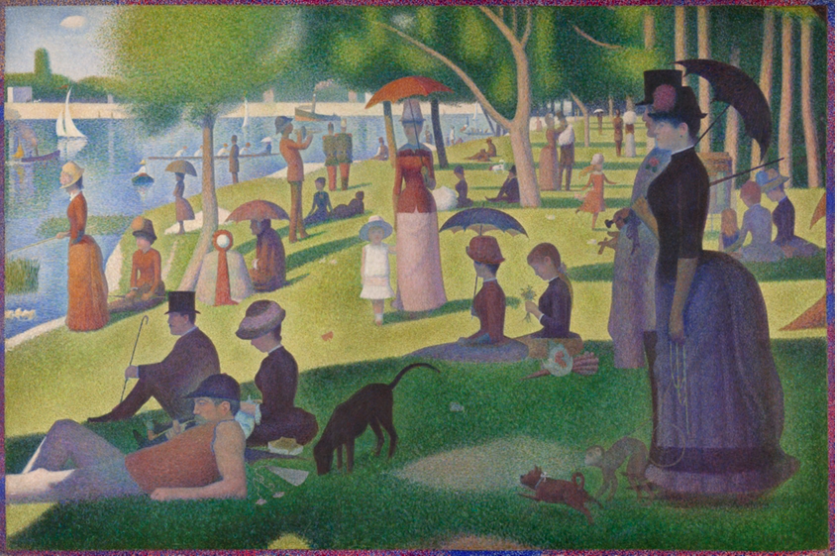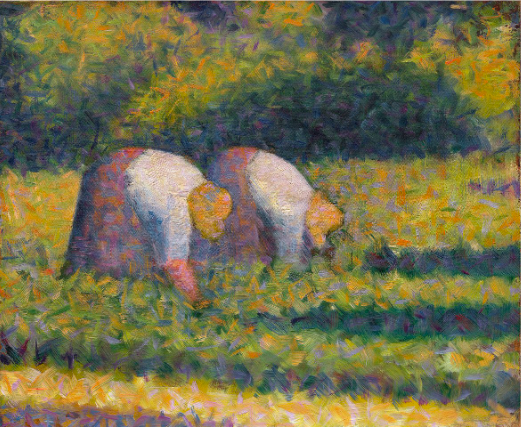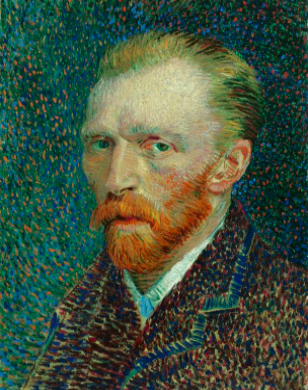Reconsidering Pointillism
March 15, 2021
There are many different art movements throughout the history of our world. Just alone we have discussed eight art movements in our college art history class. In my high school art classes, I was never really taught about art movements, but rather the artists themselves. That is why when we started discussing Pointillism in college art history, I connected it to high school because of specific artists we discussed. Although, I was taught almost absolutely nothing about Pointillism in itself, except how to recreate the art that other artists have made. In this content, it is important to notice and discuss the difference between how high school arts teach and how college arts teach art movements.
In high school, I was not taught Post-Impressionism, but I was taught Vincent Van Gogh, forms of Pointillism, and contemporary colors. I was never taught who the artists were that actually started the Post-Impressionism movement because Van Gogh actually did not do a lot with Pointillism. What I did in high school was an art style called stippling with pens. It is a form of Pointillism because we used small dots to create a piece of artwork. If we wanted an area very dark, we put lots of dots; if we wanted the area light, we spread all the dots out. By using pens though, you do not get the full effect of Pointillism that artists used from the 1880’s to 1910. Black and blue pens are not complementary colors, therefore, if a viewer were to look at my art created in high school, they would never associate it with Pointillism.
Pointillism is just a section that stems from Post-Impressionism, which started in France during the 1880’s. Other branches of Post-Impressionism were known as Neo-Impressionism, Divisionism, Symbolism, and Synthetism. When I was taught Pointillism in high school, I did not even know it branched from Post-Impressionism. I never even knew what Post-Impressionism was until we started discussing it in my Modern Art History class. The founders of Post-Impressionism were Georges Seurat, Paul Signac, Paul Cézanne, and Toulouse-Lautrec. Seurat and Signac were the two most notable artists for Pointillism in Post-Impressionism because they focused a lot on contemporary colors. When Seurat passed away, if it had not been for Signac, Pointillism would have never continued its life. To describe Pointillism, it is the use of contemporary colors in dot form to make one color stand out more than the other. So, when the viewer is looking at the artwork from a distance, they make one solid color. Whereas if the viewer looks as the artwork up close, they can see the separation of the two complementary colors. An example of this would be Georges Seurat’s painting of Sunday Afternoon on the Island of La Grande Jatte. As the viewer can see, it may look like everything is smoothly painted or slightly blurry, but that is what the dots and color do. The grass may seem green, but if the viewer were to be up close to the painting, they will see there is red mixed with green dots. The red complements the green, therefore making the green stand out. The viewer may also notice that the edges of the painting are painted instead of using dots and that’s because a lot of artists painted the borders. They just wanted to have that solid border before starting the rest of the painting with Pointillism.

Another painting of Georges Seurat would be Farm Women at Work, actually painted before Sunday Afternoon on the Island of La Grande Jatte. These two paintings were only created a year apart and yet, the viewer can see quite a difference between the Pointillism styles. From a distance, Farm Women at Work looks slightly blurry, but a viewer can still see the defining brush strokes in the painting. This is different from Sunday Afternoon on the Island of La Grande Jatte because it is not complementary dots. The paining does hold complementary colors, but they are in rough brush strokes that give the painting a fuzzy look from far away. When the viewer is up close, they will notice that defining feature of the colors and brush strokes; the separation of the colors, from which they could not notice far away. In the article, “Eugène Delacroix to Neo-Impressionism,” Paul Signac says that “By the blending of these pure colors, and by varying their proportions, they obtained an infinite quantity of colors, from the most intense to the most grey.” To be an artist apart of Pointillism, it does not matter the form it takes, but the sorts of colors and how it is applied to the canvas. This can also be seen in one of Van Gogh’s paintings, Self-Portrait, created in 1887t. If looking closely, there are a lot of different sizes of dots and even more so on the face, there are a lot of brush strokes. Not only does he use dots and brush strokes but uses complementary colors to make certain aspects stand out. Looking at the background in his painting, the viewer can see an array of orange, blue, and green dots. The blues make the oranges stand out, but they also go along with Van Gogh’s orange beard. A viewer can also notice the right half of the background is darker and there are more dots, as they are smaller. Van Gogh took in a lot of concepts to make this painting, using different techniques, but still making it a Pointillism painting. Whether it is complementary colors in dots or complementary colors in rough brush strokes; as long as there is that defining separation of colors up close, it is Pointillism. The complementary colors are what make the painting whole because they offer more to it.


After going over Post-Impressionism and learning all these new things, I really reflected on what I learned from high school. It sometimes makes me feel ashamed that schools do not teach these things more often and earlier in students’ lives. How can a person paint something without knowing what they are really painting? Vincent Van Gogh did not have a lot to do with Pointillism, he was towards the end of it, but why was I only taught about him? Why was I not taught about Georges Seurat or Paul Signac, when they both started Pointillism? It is like having somebody recreate a piece of technology, without telling them who first invented it. A person does not need to know all the facts behind a painting, but they at least need to know why a certain style was used. I never learned in high school that artists used complementary colors in their paintings to make one color stand out over the other. Learning about Post-Impressionism and Pointillism in my Modern Art class actually broke down why those colors were used. A person does not need to know all the background information to be able to paint, but they do need a little knowledge on the art movement to have an understanding of the colors and styles.
As noted through this paper, it is seen that to be able to understand an art movement and to let it have a lasting impression on a viewer, it needs to be discussed in depth. The importance of art is something people can connect to throughout their daily lives, especially with Pointillism. We see complementary colors everywhere we look, because they make each other stand out and make it more noticeable to people. Art surrounds us and we cannot notice or understand it by just discussing important artists and recreating their art.
Endnotes
Pierre Courthion. “Georges Seurat.” Encyclopedia Britannica. 30 Dec. 2020, www.britannica.com/biography/Georges-Seurat.
Adam Jolles & Britt Slavesen, Impressionism and Post-Impressionism in the Art Institute of Chicago. (The Art Institute of Chicago, 2000), Pages 98, 122-123.
Sam Phillips, …isms: Understanding Modern Art. (New York: Universe, 2013), Pages 16-17.
Paul Signac, “Eugène Delacroix to Neo-Impressionism,” in Art Theory 1900-2000: An Anthology of Changing Ideas, ed. Charles Harrison and Paul Wood (Malden: Blackwell Publishing, 2003), Pages 15-18.
Sotheby’s. “Pointillism: 7 Things You Need to Know.” Sothebys.com. 13 July 2018, www.sothebys.com/en/articles/pointillism-7-things-you-need-to-know.
David Weeks, et al. “How the Pioneers of Pointillism Continue to Influence Artists Today.” My Modern Met. 18 Jan. 2018, mymodernmet.com/pointillism-art-georges-seurat/.